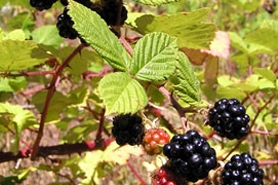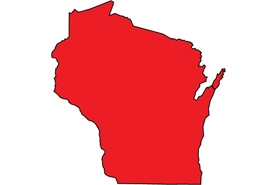Himalayan blackberry
(Rubus armeniacus)
Thicket-forming blackberry with angular arching stems that tip-root leaves with white undersides and large juicy blackberries.
Other names for this plant include:
- Scientific names: Rubus discolor, R. procerus
Classification in Wisconsin: Prohibited
- Ecological Threat
-
- This species was once introduced into the United States as a horticultural blackberry.
- Prefers full sun; also shade tolerant, flooding and drought-resistant, and adaptable to various open and wooded habitats, wetlands, riparian areas, old fields and disturbed areas.
- Forms dense, impenetrable thickets in natural habitats, dominating the forest understory by shading and crowding out native plants and impeding tree establishment.
- Spreads via seed, vegetatively through rhizomes, and by tip-rooting (tips of canes root upon contact with the ground).
- Birds readily eat and disperse the fruits, resulting in new infestations far from the initial source.
- Very invasive and widespread across the western United States, as well as in the Northeast.
- Identification
-
Leaves & Stems: Stems are erect and arching and tips root when they come in contact with the soil. Stems are reddish in color and strongly angular with large, hooked thorns. Mature canes are glabrous (smooth, without hairs). Canes die back yearly (root perennial) but remain standing through the winter. Leaves are palmately compound, usually with five leaflets, but sometimes three on younger growth. Leaflets are unequally, coarsely toothed and round to broadly oblong with a sharp tip at the apex. Leaves are green above with a white-felt or silverish hue beneath. Undersides of the leaf margins have a row of thorns.
Flowers: Flowers are white/pinkish, five-petaled with numerous stamens and borne in large terminal clusters.
Fruits & Seeds: Fruits are dry and red when immature, turning into large, shiny berries, deep purple-black when mature in fall. Fruits are edible. Berries can persist on the shrubs into winter.
Roots: At the base of the parent plant, roots form a large nodular root mass with numerous white lateral roots. Stems tip-root, forming clusters of white spaghetti-like roots.
Similar species: Common high-bush blackberry (Rubus allegheniensis; native) can look identical to the Himalayan blackberry. They both contain huge, angular stems with large thorns. Himalayan blackberry can be distinguished from other blackberries by the following:
- Undersides of the leaves on the invasive Himalayan blackberry are white-silver. This is often called “white felt.” This is similar to the appearance of the bottoms of raspberry leaves. The native species is the same color on both sides of the leaves.
- Most of the native high-bush blackberries in Wisconsin have long translucent hairs on the lower surfaces of their leaves. Himalayan blackberry is smooth with the white-grey felt and only a row of hooked thorns running along the underside of the leaf mid-vein.
- Leaves of R. allegheniensis tend to be more oblong with an extended tip than round leaves with a sharp angle.
- Himalayan blackberry tip-roots while the native does not. This means the canes arch over and the tips root when they come into contact with the soil. The native high-bush blackberry can grow tall and angle through, but the canes never tip-root into the ground.
- New growth (leaf buds) on the native high-bush blackberry is somewhat fuzzy.
- Distribution
-
Currently, there have been no reports of Himalayan blackberries in Wisconsin. Have you seen it? Please send us a report.
- Control
- Mechanical:
- Dig out plants with a shovel or pulaski. Be sure to remove the entire root mass. Although labor-intensive, this is the most-effective control option.
- Mowing effectively controls and reduces the spread of seeds but will not kill the plants. Multiple years of cutting/mowing is needed to exhaust the root systems.
- Cover infested areas with black landscape fabric for at least two growing seasons.
- Livestock grazing (mainly goats) effectively removes the vegetative mass, but this does not kill the plant.
- Plowing infested fields can significantly reduce the density.
- Foliar spray with glyphosate in the fall. Apply before the first frost.
- Selective broadleaf herbicides (such as triclopyr, 2,4‐D and metsulfuron) are effective when infestations are in open, grassy areas. Follow label limits.
- Resources
- Sources for content:
- King County Noxious Weed Control Program, Washington State.
- California Invasive Plants Council.
- Tirmenstein, D. 1989. Rubus discolor. In: Fire Effects Information System, [Online]. U.S. Department of Agriculture, Forest Service, Rocky Mountain Research Station, Fire Sciences Laboratory (Producer).


